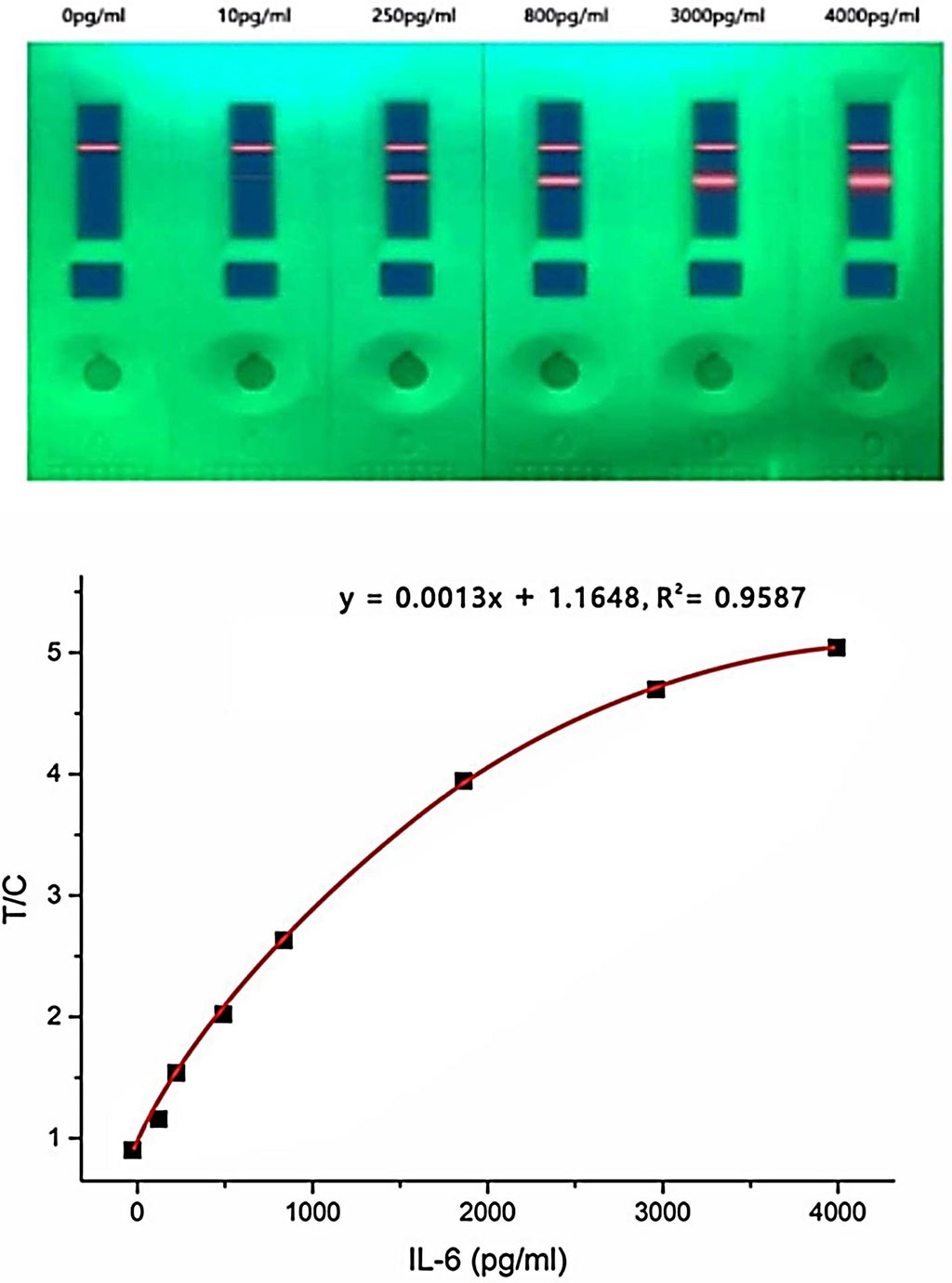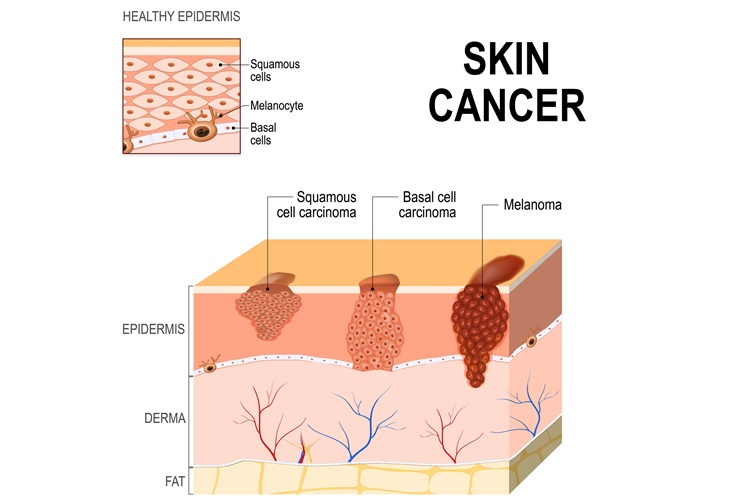Immunoassay Developed for Quantitative Detection of Serum Interleukin‐6
|
By LabMedica International staff writers Posted on 07 Apr 2021 |

Image: The quantum dot (QD)‐based fluorescence lateral flow immunoassay (LFIA) strip can rapidly and accurately detect IL‐6 levels at different concentrations (Photo courtesy of University of South China)
Interleukin‐6 (IL‐6) is a multifunctional protein and is primarily produced by macrophages, monocytes, fibroblasts, and T lymphocytes, and plays important roles in immune regulation, hematopoiesis, inflammation, and tumorigenesis.
IL‐6 has shown the highest value in the diagnosis of sepsis compared with procalcitonin (PCT) and C‐reactive protein (CRP), which are also important biomarkers of infection. Traditional IL‐6 detection methods include chemiluminescence immunoassays (CLIA), enzyme‐linked immunosorbent assays (ELISA) and electrochemiluminescence immunoassays (ECLIA).
Medical Scientists at the Second Affiliated Hospital of University of South China (Hengyang, China) developed a quantum dot (QD)‐based fluorescence lateral flow immunoassay (LFIA) strip that can rapidly and accurately detect IL‐6 levels. The QD‐based LFIA strips were fabricated by conjugating cadmium selenide/zinc sulfide (CdSe/ZnS) QDs to the IL‐6 antibody. The strips were made of nitrocellulose (NC) membranes, semi‐rigid polyvinylchloride (PVC) sheets, and polyester fiber. The IL‐6 CLIA kits were from Beckman Coulter (Pasadena, CA, USA).
The fluorescence intensity of the test (T) line and the control (C) line on the strip were detected using the self‐designed KF‐Q001‐A fluorescence immunoassay analyzer (Kingfocus Biomedical Engineering Co., Ltd, Shenzhen City, China). The QDs and antibodies were dispensed onto the strip using a piece of three‐dimensional gold‐spraying equipment. IL‐6 CLIA detection was performed on the Beckman Coulter Dxl800 instrument. A total of 200 human serum samples were obtained from a local hospital, The IL‐6 concentrations of these samples ranged from 0 to 580.42 ng/mL. The samples were detected using the strip and the Beckman IL‐6 CLIA kit within two hours of each other.
The investigators reported that the test strip's linear range was 10–4,000 pg/mL, with a linear correlation coefficient of R2 ≥ 0.959. The sensitivity of the test strip was 1.995 pg/mL. The recovery rate was 95.72%–102.63%, indicating satisfying accuracy. The coefficient of variation (CV) of the intra‐assay was 2.148%–3.903%, while the inter‐assay was 2.412%–5.293%, verifying the strip's high precision. The cross‐reaction rates with various interleukins (IL‐1α, IL‐1β, IL‐2, IL‐4, and IL‐8) and interferon‐γ (IFN‐γ) were all less than 0.1%.
The authors concluded that they had successfully established a QD‐based LFIA method for rapid and accurate detection of human serum IL‐6, providing a more simple, robust, and economic point-of-care technology (POCT) for IL‐6 quantification, which is of great value for the early detection and treatment of sepsis and related disorders. The study was published on March 24, 2021 in the Journal of Clinical Laboratory Analysis.
Related Links:
Second Affiliated Hospital of University of South China
Beckman Coulter
Kingfocus Biomedical Engineering Co., Ltd
IL‐6 has shown the highest value in the diagnosis of sepsis compared with procalcitonin (PCT) and C‐reactive protein (CRP), which are also important biomarkers of infection. Traditional IL‐6 detection methods include chemiluminescence immunoassays (CLIA), enzyme‐linked immunosorbent assays (ELISA) and electrochemiluminescence immunoassays (ECLIA).
Medical Scientists at the Second Affiliated Hospital of University of South China (Hengyang, China) developed a quantum dot (QD)‐based fluorescence lateral flow immunoassay (LFIA) strip that can rapidly and accurately detect IL‐6 levels. The QD‐based LFIA strips were fabricated by conjugating cadmium selenide/zinc sulfide (CdSe/ZnS) QDs to the IL‐6 antibody. The strips were made of nitrocellulose (NC) membranes, semi‐rigid polyvinylchloride (PVC) sheets, and polyester fiber. The IL‐6 CLIA kits were from Beckman Coulter (Pasadena, CA, USA).
The fluorescence intensity of the test (T) line and the control (C) line on the strip were detected using the self‐designed KF‐Q001‐A fluorescence immunoassay analyzer (Kingfocus Biomedical Engineering Co., Ltd, Shenzhen City, China). The QDs and antibodies were dispensed onto the strip using a piece of three‐dimensional gold‐spraying equipment. IL‐6 CLIA detection was performed on the Beckman Coulter Dxl800 instrument. A total of 200 human serum samples were obtained from a local hospital, The IL‐6 concentrations of these samples ranged from 0 to 580.42 ng/mL. The samples were detected using the strip and the Beckman IL‐6 CLIA kit within two hours of each other.
The investigators reported that the test strip's linear range was 10–4,000 pg/mL, with a linear correlation coefficient of R2 ≥ 0.959. The sensitivity of the test strip was 1.995 pg/mL. The recovery rate was 95.72%–102.63%, indicating satisfying accuracy. The coefficient of variation (CV) of the intra‐assay was 2.148%–3.903%, while the inter‐assay was 2.412%–5.293%, verifying the strip's high precision. The cross‐reaction rates with various interleukins (IL‐1α, IL‐1β, IL‐2, IL‐4, and IL‐8) and interferon‐γ (IFN‐γ) were all less than 0.1%.
The authors concluded that they had successfully established a QD‐based LFIA method for rapid and accurate detection of human serum IL‐6, providing a more simple, robust, and economic point-of-care technology (POCT) for IL‐6 quantification, which is of great value for the early detection and treatment of sepsis and related disorders. The study was published on March 24, 2021 in the Journal of Clinical Laboratory Analysis.
Related Links:
Second Affiliated Hospital of University of South China
Beckman Coulter
Kingfocus Biomedical Engineering Co., Ltd
Latest Immunology News
- Blood-Based Liquid Biopsy Model Analyzes Immunotherapy Effectiveness
- Signature Genes Predict T-Cell Expansion in Cancer Immunotherapy
- Molecular Microscope Diagnostic System Assesses Lung Transplant Rejection
- Blood Test Tracks Treatment Resistance in High-Grade Serous Ovarian Cancer
- Luminescent Probe Measures Immune Cell Activity in Real Time
- Blood-Based Immune Cell Signatures Could Guide Treatment Decisions for Critically Ill Patients
- Novel Tool Predicts Most Effective Multiple Sclerosis Medication for Patients
- Companion Diagnostic Test for CRC Patients Identifies Eligible Treatment Population
- Novel Tool Uses Deep Learning for Precision Cancer Therapy
- Companion Diagnostic Test Identifies HER2-Ultralow Breast Cancer and Biliary Tract Cancer Patients
- Novel Multiplex Assay Supports Diagnosis of Autoimmune Vasculitis
- Blood Test Predicts Immunotherapy Efficacy in Triple-Negative Breast Cancer
- Simple Genetic Testing Could Predict Treatment Success in Multiple Sclerosis Patients
- Novel Gene Signature Predicts Immunotherapy Response in Advanced Kidney Cancers
- New Technology Deciphers Immune Cell Communication to Predict Immunotherapy Response
- AI Model Accurately Predicts MSI Tumor and Immune Checkpoint Inhibitor Responsiveness
Channels
Clinical Chemistry
view channel
VOCs Show Promise for Early Multi-Cancer Detection
Early cancer detection is critical to improving survival rates, but most current screening methods focus on individual cancer types and often involve invasive procedures. This makes it difficult to identify... Read more
Portable Raman Spectroscopy Offers Cost-Effective Kidney Disease Diagnosis at POC
Kidney disease is typically diagnosed through blood or urine tests, often when patients present with symptoms such as blood in urine, shortness of breath, or weight loss. While these tests are common,... Read moreMolecular Diagnostics
view channel
Urine Test Detects Early Stage Pancreatic Cancer
Pancreatic cancer remains among the hardest cancers to detect early. In the UK, around 10,000 people are diagnosed each year, but only 5% survive beyond five years. Late diagnosis is a major factor—more... Read more
Genomic Test Could Reduce Lymph Node Biopsy Surgery in Melanoma Patients
Accurately determining whether melanoma has spread to the lymph nodes is crucial for guiding treatment decisions, yet the standard procedure—sentinel lymph node biopsy—remains invasive, costly, and unnecessary... Read moreHematology
view channel
ADLM’s New Coagulation Testing Guidance to Improve Care for Patients on Blood Thinners
Direct oral anticoagulants (DOACs) are one of the most common types of blood thinners. Patients take them to prevent a host of complications that could arise from blood clotting, including stroke, deep... Read more
Viscoelastic Testing Could Improve Treatment of Maternal Hemorrhage
Postpartum hemorrhage, severe bleeding after childbirth, remains one of the leading causes of maternal mortality worldwide, yet many of these deaths are preventable. Standard care can be hindered by delays... Read more
Pioneering Model Measures Radiation Exposure in Blood for Precise Cancer Treatments
Scientists have long focused on protecting organs near tumors during radiotherapy, but blood — a vital, circulating tissue — has largely been excluded from dose calculations. Each blood cell passing through... Read moreMicrobiology
view channel
Fast Noninvasive Bedside Test Uses Sugar Fingerprint to Detect Fungal Infections
Candida bloodstream infections are a growing global health threat, causing an estimated 6 million cases and 3.8 million deaths annually. Hospitals are particularly vulnerable, as weakened patients after... Read more
Rapid Sepsis Diagnostic Device to Enable Personalized Critical Care for ICU Patients
Sepsis is a life-threatening condition that occurs when the body’s response to infection spirals out of control, damaging organs and leading to critical illness. Patients often arrive at intensive care... Read morePathology
view channel
New Molecular Analysis Tool to Improve Disease Diagnosis
Accurately distinguishing between similar biomolecules such as proteins is vital for biomedical research and diagnostics, yet existing analytical tools often fail to detect subtle structural or compositional... Read more
Tears Offer Noninvasive Alternative for Diagnosing Neurodegenerative Diseases
Diagnosing and monitoring eye and neurodegenerative diseases often requires invasive procedures to access ocular fluids. Ocular fluids like aqueous humor and vitreous humor contain valuable molecular information... Read moreTechnology
view channel
Cell-Sorting Device Uses Electromagnetic Levitation to Precisely Direct Cell Movement
Sorting different cell types—such as cancerous versus healthy or live versus dead cells—is a critical task in biology and medicine. However, conventional methods often require labeling, chemical exposure,... Read more
Embedded GPU Platform Enables Rapid Blood Profiling for POC Diagnostics
Blood tests remain a cornerstone of medical diagnostics, but traditional imaging and analysis methods can be slow, costly, and reliant on dyes or contrast agents. Now, scientists have developed a real-time,... Read moreIndustry
view channel
Qiagen Acquires Single-Cell Omics Firm Parse Biosciences
QIAGEN (Venlo, Netherlands) has entered into a definitive agreement to fully acquire Parse Biosciences (Seattle, WA, USA), a provider of scalable, instrument-free solutions for single-cell research.... Read more
Puritan Medical Products Showcasing Innovation at AMP2025 in Boston
Puritan Medical Products (Guilford, ME, USA), the world’s most trusted manufacturer of swabs and specimen collection devices, is set to exhibit at AMP2025 in Boston, Massachusetts, from November 11–15.... Read more
Advanced Instruments Merged Under Nova Biomedical Name
Advanced Instruments (Norwood, MA, USA) and Nova Biomedical (Waltham, MA, USA) are now officially doing business under a single, unified brand. This transformation is expected to deliver greater value... Read more





















